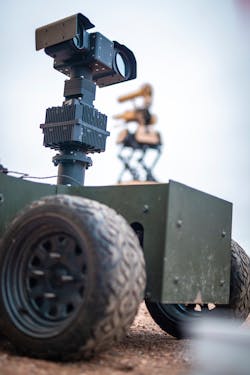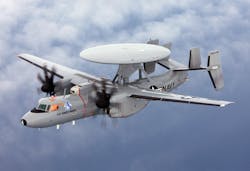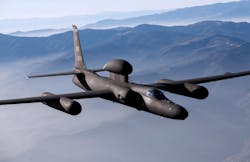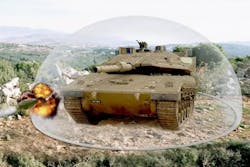Radar, short for radio detection and ranging, has been one of the most influential military technologies since World War II. It can detect and track objects as small as insects and as large as ocean-going ships and giant aircraft by bouncing radio waves of different frequencies off these targets and receiving the reflected signals. Its uses are not limited just to detecting and tracking enemy ships, aircraft, satellites, and land vehicles, but also for detailed mapping of terrain, guiding smart munitions to their targets, identifying and imaging targets, detecting and monitoring threatening weather, and even tracking flocks of migrating birds.
Radar systems designers can digitize analog RF return signals and apply sophisticated computer processing to find he most important targets in large formations of aircraft, create detailed images of distant objects to determine if they're serious threats, unveil stealthy targets designed to evade or spoof radar, separate incoming ballistic missile warheads from decoys, and give the most warning time possible in case of enemy attack.
In the last year alone, the U.S. military has undertaken many projects to develop and refine radar systems for airborne, land, and sea applications. These radar systems can defeat enemy attempts to jam them, and help guide missiles reliably to their targets. Advances in high-performance embedded computing are enhancing radar pictures like never before help safeguard U.S. and allied warfighters and civilians from sophisticated threats. This special report takes a look at some of the most important U.S. and allied radar development and deployment programs over the past year.
Land systems
Perhaps the most important radar story of the past year involves U.S. Air Force Lockheed Martin Three-Dimensional Expeditionary Long-Range Radar (3DELRR), which is to be the principal Air Force long-range, ground-based radar sensor for detecting, identifying, tracking, and reporting aerial targets.
The Lockheed Martin Corp. Rotary and Mission Systems segment in Liverpool, N.Y., won a $75 million order last April from the Air Force Life Cycle ManagementA long-established land-based air-defense radar is the Long Range Discrimination Radar (LRDR) near Fairbanks, Alaska, which helps the U.S. from ballistic missile attack. The Lockheed Martin Rotary and Mission Systems segment in Moorestown, N.J., won a $784.3 million contract from the U.S. Missile Defense Agency (MDA) in 2015 to build and operate the LRDR at Clear Space Force Station, Alaska. LRDR keeps pace with evolving ballistic missile threats and increases the effectiveness of ground based interceptors, Lockheed Martin officials say. In September the U.S. Space Operations Command at Peterson Space Force Base, Colo., announced a $31.1 million four-year order to InDyne Inc. in Lexington Park, Md., to operate and maintain the LRDR. With options the contract should be worth $316.9 million.
The LRDR combines proven solid-state radar technologies with proven ballistic missile defense algorithms on an open-architecture designed for future growth. The solid-state GaN-based radar uses Lockheed Martin’s Open GaN Foundry model, which leverages relationships with strategic GaN suppliers, company officials say. The LRDR provides a persistent midcourse ballistic missile defense system (BMDS) discrimination capability as part of a layered defense of the U.S. from ballistic missile attacks of all ranges in all phases of flight.
Last summer the U.S. Army announced a $280.1 million order to General Dynamics Land Systems in Sterling Heights, Mich., for kits to install the Trophy expedited active protection system aboard M1A2 Abrams SEPv2 and SEPv3 main battle tanks.
The Trophy system uses radar and computer processors to locate incoming anti-tank missiles and rocket-propelled grenades, and detonate the incoming munitions away from the tank. General Dynamics is working with the Leonardo DRS Land Systems segment in St. Louis to procure the Trophy active-protection system for the Abrams tank. DRS is adapting technology developed by Rafael Advanced Defense Systems Ltd. in Haifa, Israel, to help shield M1A2 Abrams main battle tanks from rocket-propelled grenades and anti-tank guided missiles.
The Trophy system isn't the only ground-based radar protecting warfighters and their equipment from anti-personnel munitions. Last April the army announced a $3.3 billion five-year contract to Lockheed Martin Rotary and Mission Systems for full-scale production of the AN/TPQ-53 counter-fire radar to detect, classify, track, and pinpoint enemy drones and incoming artillery shells without posing a risk to nearby aircraft and military forces. The so-called Q-53 is a solid-state phased array radar that detects, classifies, tracks, and determines the location of enemy indirect fire weapons like rockets, artillery shells, and mortars in either 360- or 90-degree modes. This system is replacing the aging U.S. Army AN/TPQ-36 and AN/TPQ-37 medium-range radars.
The Q-53 radar is deployed on an Army 5-ton FMTV truck, and can go into battle with heavy, medium, and light forces. A second tactical truck carries a control shelter, backup power generator, and two additional soldiers to operate the system. Lockheed Martin started developing the Q-53 counter-fire radar in 2007. The AN/TPQ-53 is designed to detect the firing points of enemy mortars, artillery shells, and rockets with sufficient accuracy to enable counter-fire artillery to destroy the enemy launcher with one shot. The Q-53 is deployable as part of the Counter-Rocket Artillery and Mortar (C-RAM) system of systems (SoS) to provide a sense and warn capability for deployed U.S. and allied forces. The system is small enough to move aboard C-130 and C-17 aircraft.
Countering UAVs has become a top priority for tactical radar systems designers. Last summer Liteye Systems Inc. in Centennial, Colo., introduced the Multi-Aerial radar
Radar aboard aircraft has become an indispensable tool for reconnaissance, surveillance, and target acquisition (RSTA). In September the Air Force Life Cycle Management Center at Wright-Patterson Air Force Base, Ohio, announced a $184 million five-year contract to the Raytheon Intelligence & Space segment in El Segundo, Calif., for the Advanced Synthetic Aperture Radar System-2 -- better-known as ASARS-2.
The imaging radar is a is a multimode real-time, high-resolution reconnaissance system carried on the U-2 Dragon Lady high-altitude reconnaissance jet with all-weather, day-night, long-range mapping capabilities. ASARS-2 detects and locates stationary and moving ground targets with precise range in search and spotlight imagery modes. It gathers detailed information, formats the data, and transmits it via wideband data link for display of fixed or moving ground objects. The imaging radar can produce extremely high-resolution images from long stand-off ranges and provides the highest resolution radar ground maps available today, experts say.
A year ago Lockheed Martin Rotary and Mission Systems started signal-processing upgrades to the U.S. Navy E-2D carrier-based radar early warning aircraft. Lockheed Martin is building seven retrofit advanced radar processor systems for the E-2D Advanced Hawkeye tactical airborne early warning (AEW) aircraft that operates from aircraft carriers. The E-2D uses Lockheed Martin's AN/APY-9 radar for Navy carrier surveillance and theater air and missile defense missions. radar provides the enhanced airborne command and control and expanded surveillance for the E-2D. The radar detects small maneuverable targets in difficult coastal-water and overland environments.
The AN/APY-9 radar for the E-2D surveillance aircraft features advanced radar signal processing subsystems to enable flexible radar beam management and enhanced target processing to help the radar pinpoint and track enemy aircraft and missiles, and reject clutter and radar interference. It has mechanical and electronic scanning modes, providing the warfighter with 360-degree situational awareness around the aircraft, and the ability to augment mechanical scanning with electronic scanning to dedicate extra resources to challenging targets or 90-degree sectors in any direction. The AN/APY-9 Radar detects air and sea surface targets simultaneously with its space-time adaptive processing (STAP) architecture, which suppresses clutter, jamming, and other sources of electromagnetic interference to focus on the target.
November 2021 also saw a $770 million U.S. Air Force contract to Georgia Tech Applied Research Corp. in Atlanta to build the Advanced Radar Threat System - Variant 1 (ARTS-V1) -- a mobile advanced radar system to help combat aircraft pilots learn to operate safely in hostile areas guarded by modern radar-guided surface-to-air missiles. The ARTS-V1 system is for U.S. military training ranges to help pilots of several different aircraft types -- especially for 5th generation aircraft like the F-35 joint strike fighter.
In October 2021 the Air Force awarded an $80.7 million order to the Lockheed Martin Missiles and Fire Control segment in Grand Prairie, Texas, to build five Advanced Radar Threat System - Variant 2 (ARTS-V2) systems, and for ARTS-V2 production option two. The ARTS-V2 is a ruggedized mobile system designed to emulate radar-guided surface-to-air missile threats. Lockheed Martin will build the ARTS-V2 to provide threat-representative radar tracking and reaction such as acquiring, tracking, and engaging several aircraft simultaneously with representative receiver, processor, and electronic counter-countermeasures.
Maritime radar
It's common to think of air traffic control (ATC) radar for coordinating aircraft at large airports, but U.S. Navy aircraft carriers need the same kind of radar to keep carrier operations moving smoothly. In September Saab Inc. in East Syracuse, N.Y., won a $31.7 million Navy order for AN/SPN-50(V) 1 shipboard air traffic control radar systems to replace the Navy’s AN/SPN-43C radar aboard aircraft carriers and amphibious assault ships.
The AN/SPN-50(V) 1 radar enables shipboard air traffic controllers to identify, marshal, and direct aircraft within a 50-nautical-mile radius of the ship. The order includes two on-board repair kits, and two depot spares kits. In recent years, the top 25 percent of the AN/SPN-43C frequency band has been reallocated to the fixed wireless access community prohibiting air traffic control and air search radar operation within 50 nautical miles of the coast, Navy officials say. The AN/SPN-50(V)1 radar is one of the U.S. versions of Saab’s Sea Giraffe agile multi beam radar, functions as the primary air traffic control surveillance radar for manned and unmanned aviation aboard the Navy’s nuclear-powered aircraft carriers and large-deck amphibious assault ships.
Above decks, the radar uses a mechanically rotating, electronically stabilized antenna. The 1,500-pound antenna consists of dual planar arrays mounted back-to-back, each connected to independent transmitters and receivers. Below decks, the radar consists of processor, receiver/exciter, and transmitter cabinets; radar set control; and motor generator. The processor cabinet performs signal processing, tracking, and interface functions. The receiver/exciter has three receivers, and generates system frequencies and clocks. The transmitter cabinet receives the RF pulses from the receiver/exciter and amplifies them for output to the antenna.
Two of the most influential maritime radar projects involve the Dual Band Radar (DBR), and the Enterprise Air Surveillance Radar (EASR) from Raytheon Missiles & Defense. The DBR surface-search radar system for large U.S. Navy warships combines the benefits of S-band and X-band radar capabilities for a range of environments, while its open architecture software design enables automatic operation with minimal human intervention. Unfortunately, Navy leaders have deemed DBR to be too expensive, and are switching large-deck surface warships to the EASR. Its only installation is aboard the aircraft carrier USS Gerald R. Ford.
Last April Raytheon won a $19.1 million order to support the expensive DBR until EASR comes online for the aircraft carrier USS John F. Kennedy -- the second ship of the Ford class -- to replace the discontinued DBR. The America-class amphibious assault USS Bougainville (LHA 8), under construction in Pascagoula, Miss., is expected to be the first ship that will take EASR to sea. Raytheon's EASR capitalizes on an existing radar modular assembly (RMA) architecture matured on the company's Air And Missile Defense Radar (AMDR) -- also called the SPY-6 radar -- for next-generation Navy Aegis combat systems for Arleigh Burke-class cruisers.
EASR is for different ship classes for ship self-defense, situational awareness, air traffic control, and weather monitoring. The Radar Modular Assembly (RMA) affords EASR the scalability for a variety of ship sizes across diverse missions for advanced capabilities and affordable costs, company officials say.
The Raytheon AMDR will be integrated into late-model Arleigh Burke-class (DDG 51) Aegis destroyers. Raytheon won a $650.7 million Navy order last March for AN/SPY-6(V) shipboard radar hardware. The Raytheon AN/SPY-6(V) AMDR will improve the Burke-class destroyer's ability to detect hostile aircraft, surface ships, and ballistic missiles, Raytheon officials say. The AMDR will supersede the AN/SPY-1 radar, which has been standard equipment on Navy Aegis Burke-class destroyers and Ticonderoga-class cruisers. The radar will provide greater detection ranges, increased discrimination accuracy, higher reliability and sustainability, and lower costs, compared to the AN/SPY-1D(V) radar onboard today’s Burke-class destroyers. The system is built with individual building blocks called radar modular assemblies (RMAs), Raytheon officials say. Each RMA is a self-contained radar in a two-cubic-foot box; RMAs can stack together to form any size array to fit ship mission requirements.
Modern military radar systems use synthetically steered radar beams that operation in many different RF frequencies that not only detect potential targets of interest, but also can identify these targets through sophisticated radar imaging.
Making this possible today are advanced embedded computing systems for digital signal processing that capitalize on the today's most advanced general-purpose processors (GPPs), field-programmable gate arrays (FPGAs), general-purpose graphics processing units (GPGPUs), real-time software, and innovative architectures.
Signal processing is just as important for advanced radar as it is for electronic warfare (EW) systems, says Denis Smetana, senior product manager at the Curtiss-"Radar has its own unique system needs that differ from EW applications. When it comes to the front end of the system, which typically is some type of FPGA device, one key difference is the importance of latency," Smetana explains. "Receiving and responding to data in an EW system, because you are trying to spoof, or in some way modify the signal coming in so your adversary doesn't detect what you are doing. Minimizing latency is more important in EW than it is in radar."
Radar, on the other hand, is more uni-directional than EW systems. Although radar may be less interrupt-driven than radar, today's military radar systems increasingly are using a growing number of radar transceivers in different locations to produce a high-fidelity picture of the battlefield, as well as to use stealth techniques to confuse the enemy.
"In radar you have signals from many to hundreds of sensors coming in, and you can have fiber optics coming from front-end sensors to an FPGA device that will do that first level of processing and filtering, and then you pass that on to more of a general-purpose processor," Smetana says. "An FPGA could have 100 different streams of data coming in, and the FPGA says here's five of that 100 signals that warrants a deeper look and requires more processing."
This kind of processing can give analysts deeper information into what targets are and what they are doing, Smetana says. It can compare the radar signals of contacts with profiles of known targets to start making judgments of the potential intentions of those targets.
Artificial intelligence (AI), machine learning, and parallel-processing capabilities of today's signal processing architectures also can relieve analysts of differentiating targets, and also can help humans by making some preliminary decisions and eliminating many possibilities without human intervention.
The new Ice Lake D processor from Intel Corp. in Santa Clara, Calif., is expected to have a major influence on radar signal processing in the near future, Smetana says. "Ice Lake D has capability that helps radar processing; its floating point engine can do twice as many floating point operations in parallel than it could do before.
The Ice Lake D also has optimizations that improve its AI and machine learning by an order of magnitude over the previous generation of the Intel Xeon D processor family, Smetana points out. the Curtiss-Wright Champ XD3 embedded computing systems uses the Ice Lake D devices, aligns to the Sensor Open Systems Architecture (SOSA) industry standard, and is optimized for signal processing in RF and electro-optical sensors.
Who's who in radar systems design
BAE Systems Electronic Systems
Nashua, N.H.
https://www.baesystems.com/en-us/our-company/inc-businesses/electronic-systems
DRS Laurel Technologies
Johnstown, Pa.
https://www.leonardodrs.com/locations/naval-electronics-laurel-technologies-johnstown-pa/
Echodyne Corp.
Kirkland, Wash.
https://www.echodyne.com
Elta Systems Ltd., a division of Israel Aerospace Industries (IA)
Ashdod, Israel
https://www.iai.co.il/about/groups/elta-systems
General Dynamics Land Systems
Sterling Heights, Mich.
https://www.gdls.com
Georgia Tech Applied Research Corp.
Atlanta
https://gtrc.gatech.edu/gtarc
InDyne Inc.
Lexington Park, Md.
https://www.indyneinc.com/corporate/
Liteye Systems Inc.
Centennial, Colo.
https://liteye.com
Leonardo DRS Land Systems
St. Louis
https://www.leonardodrs.com/who-we-are/our-segments/land-systems/
Lockheed Martin Missiles and Fire Control
Grand Prairie, Texas
https://www.lockheedmartin.com/en-us/who-we-are/business-areas/missiles-and-fire-control.html
Lockheed Martin Corp. Rotary and Mission Systems
Liverpool, N.Y.
https://www.lockheedmartin.com/en-us/who-we-are/business-areas/rotary-and-mission-systems.html
Northrop Grumman Mission Systems
Linthicum Heights, Md.
https://www.northropgrumman.com/who-we-are/business-sectors/mission-systems/
Rafael Advanced Defense Systems
Haifa, Israel
https://www.rafael.co.il
Raytheon Intelligence & Space
El Segundo, Calif.
https://www.raytheonintelligenceandspace.com
Raytheon Missiles & Defense
Tewksbury, Mass.
https://www.raytheonmissilesanddefense.com
Saab Inc.
East Syracuse, N.Y.
https://www.saab.com/markets/united-states
About the Author
John Keller
Editor-in-Chief
John Keller is the Editor-in-Chief, Military & Aerospace Electronics Magazine--provides extensive coverage and analysis of enabling electronics and optoelectronic technologies in military, space and commercial aviation applications. John has been a member of the Military & Aerospace Electronics staff since 1989 and chief editor since 1995.





